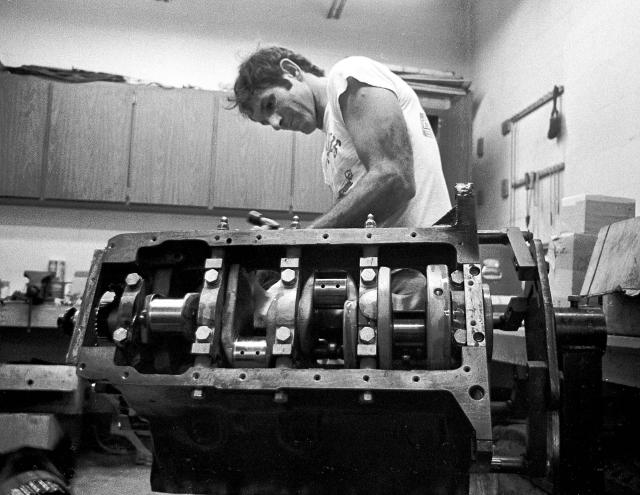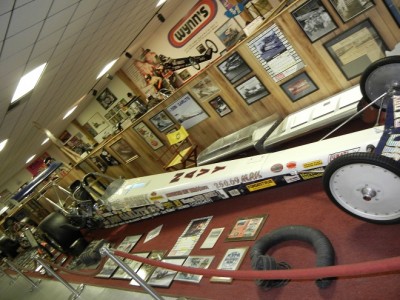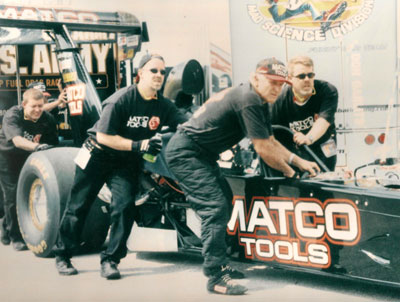As much as Don Garlits was defined by his slew of amazing performances on the track during his career, he was also defined by his cars. There were a total of 37 machines that carried the vaunted Swamp Rat name into straight line battle. Sure, the numbers stop at Swanp Rat 34 but you have to remember that there were certain numbers that had “B” cars. For instance, there is a SR 6 and 6B. The 37 cars are an amazing record of the evolution that top fuel dragsters underwent from the 1950s into the present day. As you’ll see from his picks below, Garlits has a fondness for some cars that we wouldn’t expect him to and he knows exactly where he made mistakes over the years.
I had a recent conversation with a friend about some similarities between Don Garlits and baseball legend Ted Williams. We agreed on several points that both men shared the same sort of competitive drive, singular focus, and mental wherewithal to see and understand things that were happening around them better than others ever have in their respective sports. At some point during the conversation I said that Garlits’ setting a speed record that stood for SEVEN YEARS without being broken was more of an accomplishment than Ted Williams’ famous .406 batting average season. As my buddy got wound up in defending the Splendid Splinter, I was quick to remind him that Williams didn’t manufacture his own bats. Garlits built the vast majority of those 37 cars that carried he and some hired drivers to victories literally all over the world and that is a major league trump card in my book.
When I pitched Don the idea for this story I asked that he choose his favorite five Swamp Rat dragsters. He went above and beyond and selected six. Hey, I was fine with that! So below we’re going to profile his picks in his own words and add our two cents, some history, and a few factoids you may not have known about these most special six machines in the career of Don Garlits!
In numerical order from oldest to newest…here we go!
Why he chose it: “It put my name on the map!”
What we say: It makes total sense for Don to choose this piece as one of his “top six” Swamp Rats. It was a car that brought him great joy, and also great pain. Built in 1956, this was the machine that made the fateful trip to California in order to square up with all the greatest names in the sport for the 1959 March Meet. He was driving out from “swampy ol’ Florida” as he called it, right into the lions den. The hotbed of drag racing, the crucible of the sport, and he was heading there without a supercharger. After a valiant effort that was just not good enough in a field of blown top fuel dragsters, Garlits immediately, and we mean immediately installed a supercharger at Ed Iskenderian’s shop and went on to win the final two races he was slated to appear at in California. It was the hammer being thrown down. He faced all of the detractors out west who said he was a nobody that was running on faulty clocks, and he throttled ’em all…twice in a row.
Back east, the car was an absolute terror that few had any hope of touching. Unfortunately in June of 1959 the car exploded while Don was making a pass and it bathed him in fire, burning him badly and forcing him out of the seat. At the time he claimed that he’d never drive again. Famously, that statement was disproven in a far shorter time frame than doctors would have liked. Modified for his pal Art Malone to drive, the car was reclassified as SR 1-B. The car was retired in 1961, restored in the late 1970s by Don and his guys to be used at the 25th US Nationals that same year. Times being what they were, Garlits as allowed to run the machine full tilt and it went 165mph! In 1988 it was pulled out again and run at Bristol to the tune of 182mph! That’s without the blower! This car has a prime spot in the Garlits museum and we can see why.
Why he chose it: “This was the car that set the NHRA record over 200mph (201.34)
What we say: The story of SR 6B is a good one. This machine actually started life as Art Malone’s car and he wasn’t happy with it. Malone couldn’t get the car to run as he wanted. Garlits returned from a trip to the west coast without a car (he sold SR6 to another racer on the voyage) and set about welding himself up a new car. Malone thought that Garlits had learned some new trick stuff while on tour out west and he actually traded his car for the chassis that Don was welding for himself! In the hands of Gar, this dragster became a virtual wrecking machine. Most famously it ran 201.34 miles per hour at Island Dragway in Great Meadows, NJ to become the first car “officially” over 200mph in the quarter mile (Save the Karamesines comments for another day). After that, SR6 won the 1964 US Nationals, went to England with the NHRA contingent that toured the country, came home and won the 1965 March Meet, and was then sold to a group of racers who wanted it. As (bad) luck would have it, Don had one last match race appearance to make with the car and he rolled it over at Island Dragway (ironically the site of an amazing triumph a year earlier). The buyers got their money back, the car got stored and in 1986 Gar and Herb Parks restored it. SR 6B now rests comfortably at the museum in Ocala, Florida.
Why he chose it: “This one blew my foot off and brought on the rear engine cars.”
What we say: If we apply the old saw, “The darkest hour is just before dawn” to top fuel drag racing, the zenith of (traditional) front engine dragster performance during the late 1960s/early 1970s was that proverbial dark hour. Yes, the speeds and elapsed times being achieved were mind blowing, but the death toll was mounting. Cluches were exploding, sawing cars in half and killing drivers. Drivers were being burned to death in high profile fires. Men like Mike Sorokin, beloved by throngs of fans, were killed in gruesome public displays before packed houses. Something had to change and as it turned out, SR 13 was the wick that lit off a near instantaneous sea change in the sport of drag racing. Someone had to figure out a way to get all that fire, all that exploding driveline, and all that danger out of the driver’s face. As Don Garlits lay in a California hospital, he was determined to be that man. The thing to remember about SR 13 is that the car itself didn’t fail Garlits, it was the transmission contained within it that did explode and forcibly remove a large portion of Don’s foot on the starting line of Lions Drag Strip during that bad afternoon in 1970. While mending in the hospital, Garlits sold the car to his right hand men Connie Swingle and TC Lemons. Those guys fixed it and took it out racing again. Garlits actually jumped into the seat during the Bristol race and set low elapsed time and top speed of the meet in one fell swoop. Amazingly, Garlits drove the car for the rest of the season and finally in the fall of 1970 Art Malone bought the car. It is now back in the museum. Outside of the whole explosion and disaster thing, I think that SR 13 is one of the coolest, most brutally minimal, gnarliest looking front engine diggers ever. The car’s history can’t help but influence that thought but jeez…it looks mean!
Why he chose it: “This car won the first NHRA championship sponsored by Winston and set the speed record that stood for seven years.”
What we say: Like a trusty companion, some cars just mean more than others and this is what we’re feeling with Don’s inclusion of SR 22 in this list. Lots of guys who have been around drag racing for decades talk about the 1975 NHRA World Finals as the greatest race that they had ever seen. Some people call it one of the great drag races of all time. It was SR 22 that played a major role in those opinions. For one, Garlits was in a heated battle with 1974 NHRA top fuel champ Gary Beck and it was coming right down to the wire. Entering the race, Don was 148pts behind Beck and needed a virtually perfect weekend to catch him. The field was the first all 5-second qualified group in NHRA history and Beck landed the first blow with a 5.69-second lap making him the first driver into the 5.60s in drag racing history. Like a prize fighter who was waiting for the perfect moment to unleash his biggest punch, Garlits reeled back, tuned the dragster up onto the “puree” setting and went 5.63/250.69 becoming drag racing’s first 250mph man. No one would eclipse his speed for a mind boggling seven years. If there was a true “prime” in the career of Garlits it would have been the mid to late 1970s. Think about this. From 1975-1979 of the 20 NHRA national events contested, Garlits won 16 of them. He also destroyed everyone on the IHRA side and in AHRA competition. It wasn’t even worth showing up if your name wasn’t “Big Daddy”.
Why he chose it: “Swamp Rat 24 won the most money, over $600,000 in a two year period during the 1970s.”
What we say: This thing was a long wheelbase, nitro powered cash machine on wheels. As we mentioned above, Garlits was swinging for the fences a lot during the middle and late 1970s. This car was a big reason for it. Originally built with a three speed transmission, the guys put it back to a two speed (yes top fuelers had transmissions then!) and off they went…winning nearly every race they entered over a two year period in national even competition. Match races? Yeah they slayed ’em all at an amazing rate at those, too. Corrected for inflation the $600,000 in winnings is OVER $2,000,000. That’s without a fleet of huge big rigs, a raft of CNC stations machining engine blocks around the clock, a blower dyno, or anything that today’s top tier teams “need” to be competitive. Power was provided by an aluminum 417ci Donovan hemi. It was big stuff when Grumpy Jenkins earned $250,000 in one year during the early 1970s. Garlits doubled it plus 100K at the end of the decade. Amazing. Oh, and the paint color isn’t black. Why? The Navy was going to sponsor Garlits for $50,000 and they apparently pulled the plug when Don put a cross and the words “God is Love” on the cowl of the car. That was a brilliant decision, eh?
Garlits Pick: Swamp Rat 34
Why did he choose it: “Swamp Rat 34 is still the most modern and cutting edge top fuel dragster in the world!”
What we say: Swamp Rat 34 was a wonder when it was built as a collaboration between Don Garlits and Murf McKinney in the mid 1990s. Using a mono-strut wing, lower frame rails that also acted as fuel lines, a very low driving position, enclosed drivers area under a canopy, and a host of other innovations, the NHRA saw it as the thing that wouldn’t die. Debuted in 1994, it ran for a couple of seasons before Garlits decided to retire and the car entered the museum that Garlits operates. Along came 2001 and Garlits decides to haul this car out of the mothballs and get after it on the NHRA tour again. This decision opened a huge can of worms and controversy as the NHRA had since made rules outlawing some of the technology used in the car that was virtually impossible to fix without destroying the car and starting over. The NHRA relented and Garlits was able to run the car at selected events, ultimately running a best of 4.76/323mph. It last ran at the 2003 US Nationals and there it hustled to a best 310mph lap.
Here’s what Don had to say about the saga of SR34 –
Swamp Rat 34 came at a very bad time, NHRA was already trying to slow the
T/F Dragsters down and here was a design that was going to increase the
performance. SR 34 gained 65 MPH from the eight mile to the finish, on the
323.04 run in Gainesville during the 2003 Gatornationals, this was 3 MPH
more than anybody had ever gained in that distance, plus, I was not pushing
the engine at all! I actually drove the car 150 feet past the finish line,
without any engine damage! I was testing the vehicle for handling and the
front wheel speed tracking devise recorded 340 MPH, before I lifted, and the
car drove like a dream! NHRA had to get rid of this design, and quick! This
is why they have given the Schumacher Team so much hassle.
So there you have it. The six greatest Swamp Rats in the lineage as chosen by Don Garlits. You can disagree on these selections but your opinion will be wrong. We want to extend a special thanks to Don for his time and help in compiling information for this story. It means a lot to us and he deserves a big thanks for his cooperation.
Please visit www.Garlits.com to learn more about Don, the museum, the international drag racing hall of fame, and lots more!




















simply the best ever. sure others have gone faster, won more but with mr garlits they would not have. thanks for the memories sir.
If you are ever in the Ocala Fla area, stop into the drag racing museum. Right off of the freeway. Plan to spend most of a day.
A good friend asked how do you spell his name and I told him Mr. Don Garlits or just say Big Daddy Don Garlits, for he has surely earned all his success and surrounded himself with great people. We are so glad that Mr. Garlits has done what he has and continues to think ahead, a real role model. Thank You so much.
So glad i made it to the MOPAR show last year. The museum is awesome!! A highlight of the show was definitely Don telling war stories for hours. I’ll listen to that stuff for as long as he wants to talk! Very cool.